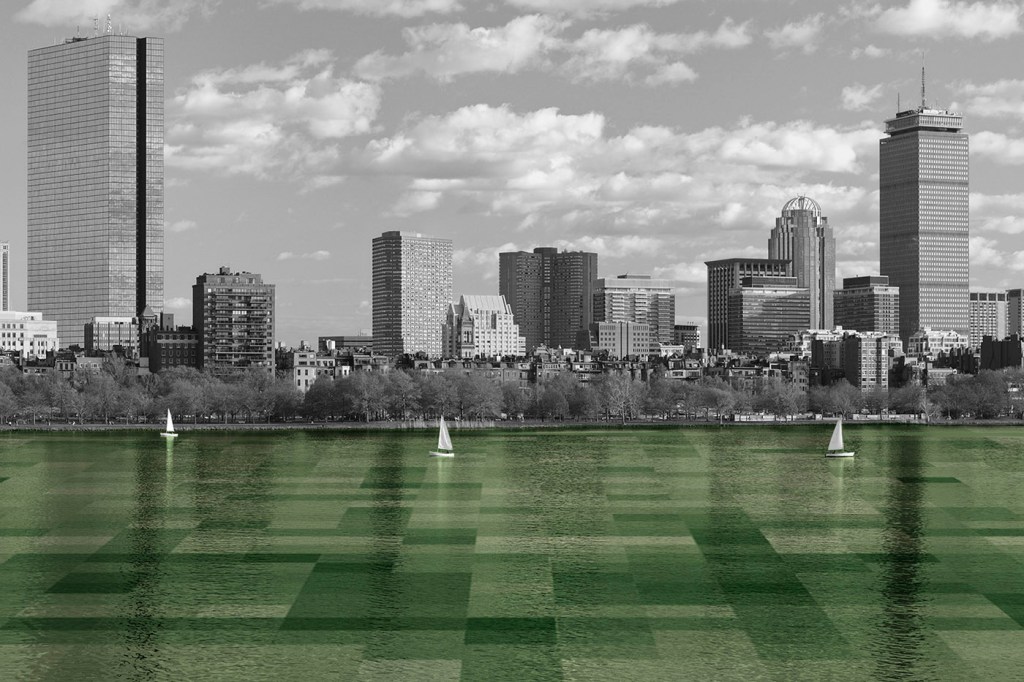You love that dirty water. But how dirty is it really?

In 1965, the water in the Charles River was so dirty that The Standells wrote a song about it. It was the same year the Charles River Watershed Association launched the first major effort to improve the quality of the river, which had been polluted by raw sewage and rainwater that flowed from old drainage pipes in Boston Harbor.
Now the “Dirty Water” Boston sports fans have come to love could soon host its first public swimming area. But there are still significant hurdles to overcome before that could become a reality.
“We are not on track to equal last summer in terms of water quality at the proposed site for the swimming park,” said Max Rome, a doctoral candidate at Northeastern who received a grant from the Charles River Conservancy to test the quality of the water.
Rome found high levels of E. coli and cyanobacteria at the swimming site, which can cause severe abdominal cramps, headaches, and pesky rashes.
The collaborative effort to reduce pollution levels in the Charles—with contributions from Northeastern researchers over the years—speaks to a narrative familiar to city officials across the country who are working to upgrade their urban waterways.
Their goal is to improve the safety of polluted rivers such as the Big Sunflower River, a tributary of the Mississippi River. American Rivers, a river conservation organization, named Big Sunflower the most endangered river in the United States in 2018.
Ameet Pinto, an assistant professor of civil and environmental engineering at Northeastern, said that drainage from the Mississippi’s polluted waters in 2017 created the largest “dead zone” ever recorded in the Gulf of Mexico—an 8,776 square-mile of pollution approximately the size of New Jersey.
The federal National Oceanic and Atmospheric Administration estimates that this year’s “dead zone” from the Mississippi River will be smaller in comparison, about the size of Connecticut.
“A dead zone is where water doesn’t have enough oxygen for fish to survive,” said Pinto, who studies drinking water and wastewater systems in urban areas.
A major effort is now underway to eliminate millions of pounds of chemicals from the Ohio River, the largest tributary of the Mississippi River, which provides drinking water to 5 million people.
And New York officials are working to remove nitrogen from the East River, which treatment plants in New York and Connecticut have long used as their dumping ground. As with the Charles, a proposed swimming area in the East River is now under review.
One thing’s for sure: factories, farms, and waste treatment facilities can no longer get away with dumping chemicals in rivers.
“There are many urban rivers that do not have as consistently good water quality as we see in the Charles,” said Emily Bender, a public affairs specialist for the EPA.
The Charles River flows 80 miles from Echo Lake in Hopkinton to the Boston Harbor. The river travels through 23 cities and towns, including Dover, Natick, and Cambridge.
A federal court order issued by the EPA and the Department of Justice demanded the city of Boston to reduce rainwater combined with sewage in the Charles to 13.1 million gallons by 2021, a requirement that is expected to be met.
Other communities, including Watertown, Waltham, and Newton, have been told by the EPA to clean up their portion of the river.
The level of bacteria in the Charles has dropped significantly over the past 30 years. Thirty million gallons of wastewater containing untreated human waste, industrial waste, and other debris was discharged into the river in 2017, down from 1.7 billion gallons in 1988.
The Boston Water and Sewer Commission is now working to clean up the Muddy River and Stony Brook, two streams located on the south side of the Charles Basin.
The Charles River Watershed Association is monitoring more than three dozen sites this summer, but has only discovered one abnormality: an annual cyanobacteria bloom outbreak.
The testing is based partially on modeling by former Northeastern Professor Ferdi Hellweger, who spent years studying the dynamics of the water quality on the Charles and how and why it changes.
“The Charles River overall does not look to be more polluted than previous years, but it sounds like there might be a more localized source of pollution,” said Elizabeth Cianciola, a scientist for the Watershed. “We don’t sample that far downstream.”
In 2016, E. coli concentrations at the proposed swim site met the standard for safe swimming every time scientists tested the water. This summer, E. coli samples from the swim site exceeded state and federal swimming and boating standards on some rainy days.
“We have already recorded multiple days in which E. coli and cyanobacteria exceeded these levels,” said Rome.





